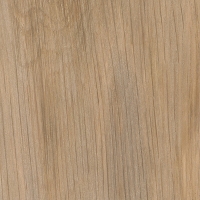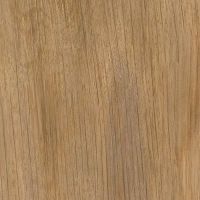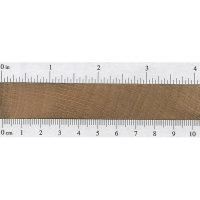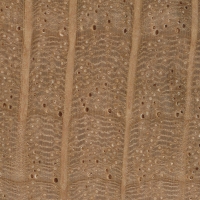 |
Common Name(s): Tanoak Scientific Name: Notholithocarpus densiflorus Distribution: Western United States Tree Size: 65-100 ft (20-30 m) tall, 3-5 ft (1-1.5 m) trunk diameter Average Dried Weight: 42 lbs/ft3 (675 kg/m3) Specific Gravity (Basic, 12% MC): .56, .67 Janka Hardness: 1,420 lbf (6,290 N) Modulus of Rupture: 16,650 lbf/in2 (114.8 MPa) Elastic Modulus: 2,071,000 lbf/in2 (14.29 GPa) Crushing Strength: 8,250 lbf/in2 (56.9 MPa) Shrinkage: Radial: 4.9%, Tangential: 11.7%, Volumetric: 17.3%, T/R Ratio: 2.4 |
Color/Appearance: Sapwood is very wide and not clearly differentiated from the heartwood; both are light to medium reddish brown, with the color darkening with age.
Grain/Texture: Grain is generally straight, with a uniform medium to coarse texture.
Endgrain: Diffuse-porous to semi-ring-porous; exclusively solitary; medium to large pores arranged radially, few; parenchyma banded; narrow and very wide rays, spacing close.
Rot Resistance: Rated as non-durable to perishable; poor insect resistance.
Workability: Good workability with machine or hand tools, though lumber can be challenging to dry without defects or discoloration. Poor dimensional stability. Glues, stains, and finishes well.
Odor: No characteristic odor.
Allergies/Toxicity: Besides the standard health risks associated with any type of wood dust, no further health reactions have been associated with Tanoak. See the articles Wood Allergies and Toxicity and Wood Dust Safety for more information.
Pricing/Availability: Availability is generally limited to local sources, most commonly as flooring planks or veneer, though solid lumber is sometimes available. Prices should be moderate for a domestic hardwood.
Sustainability: This wood species is not listed in the CITES Appendices or on the IUCN Red List of Threatened Species.
Common Uses: Veneer, flooring, railroad cross-ties, and furniture.
Comments: Tanoak is close to true oak in both appearance and workability, though it’s not in the Quercus genus. The wood can be thought of as an untamed beast: it has an excellent strength-to-weight ratio (for both MOR and MOE), but has very high movement in service.
None available.
None available.
Scans/Pictures: A special thanks to Ken Forden for providing the wood sample of this wood species.
 |
 |
 |

|





I recently used some Tanoak for the feet of a little table. The supplier mentioned that it was dried according to the program developed for this species by Oregon State Univ. The piece I received was, well, “flat as a board”, and though I have only had it in my possession for just over a month, I see no reason to believe it will be unstable. The strength seems impressive, and the wood was fun to work with. I think this species would indeed make excellent flooring. A few items that I have read said that this wood usually finds… Read more »
We have considered using it for flooring and I have notice one or two companies that sell tan oak flooring.